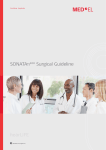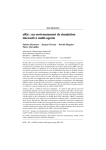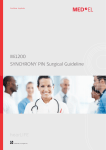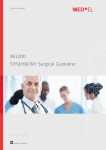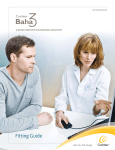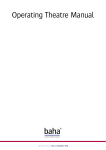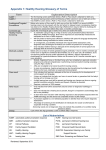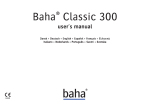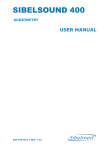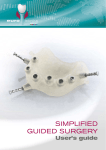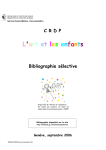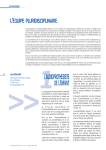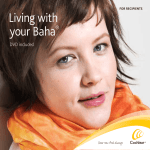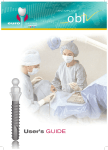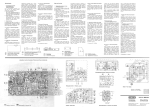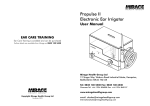Download E80650A Audiological Manual GB - Single
Transcript
Audiological Manual Products in this manual are protected by the following patents: US 5 735 790, US 5 935 170, EP 0715839, EP 0715838 and corresponding patents in other countries and pending patent applications. All products can be subject to change without notice. No part of this publication may be replaced, stored in a retrieval system, or transmitted, in any form by means, electronic, mechanical, photocopying, recording or otherwise, without the prior written permission of the publisher. Caution: Federal law (USA) restricts this device to sale by or on the order of a medical practitioner. ©Entific Medical Systems AB, 2005. All rights reserved. Contents Note: This manual is designed to be used in conjunction with the following appendices: Appendix A – Basic Patient Data, Appendix B – Pre-operative questionnaire, Appendix C – Post-operative questionnaire, Appendix D – Service/Repair questionnaire • • • • Introduction Background Patient selection 4 4 5 Conductive hearing loss 5 Single Sided Deafness (SSD™) 5 Otological indications 5 Audiological indications 5 Additional indications 6 Pre-operative evaluation 7 Audiological measurements 7 Fitting range 8 Psychological aspects of patient selection 8 Selection of implant side 9 Bilateral implants 9 Baha for Single Sided Deafness 9 ® • Fitting procedure • • • Maintenance Follow up Post-operative evaluation 10 Patient kit 11 12 12 13 Objective evaluation 13 Subjective evaluation • 13 Young/small children and Baha ® Pre-operative evaluation 14 ® Baha Softband and Baha Headband 14 Fitting the Baha® Softband 14 Further use of the Baha Softband/Headband 15 ® ® • • • • • • • • • • • • 14 Baha Divino™ Baha® Compact Baha® Classic 300 Baha® Cordelle II Accessories 16 18 19 20 23 Telecoil unit 23 FM receiver 23 Directional microphone 23 Audio adapter 23 General advice Troubleshooting 25 26 Feedback problems 26 If the Baha® device is silent 26 Bad sound quality 26 If the Baha® device has become damp/wet 26 Skinproblems 26 Case studies Service & repair References For further reading, examples of Baha® studies Graphs 27 32 33 34 35 Audiological Manual 3 I n t r o d u c t i o n & b a c kg r o u n d Introduction & background Introduction Since 1977, osseointegrated implants have been shown to provide successful retention for bone anchored sound processors. The system is called Baha® and utilises Brånemark System® implants in combination with a bone anchored sound processor (see Fig. 1). This system has proved to be a favourable means of providing hearing rehabilitation through direct bone conduction for certain groups of patients. To install the Baha system, a small titanium implant is placed in the bone behind the ear where it osseointegrates. The vibrations from the sound processor are transmitted to the implant via a percutaneous abutment. This in turn makes the skull bone vibrate and the bone then acts as a pathway for sound to travel to the inner ear without involving the ear canal. Fig. 1 The sound processor can (after a healing period) then be connected and disconnected at will. The surgical procedures can be performed under local anaesthesia and can be regarded as minor surgery from both the doctor’s and patient’s point of view. Background One common dilemma for otologists when treating patients suffering from middle ear disease, is to obtain a dry ear with good hearing. If the patient uses an air conduction (AC) hearing aid, the ear mould in the ear canal usually aggravates the ongoing infection in the middle ear and the ear canal. When using the Baha system the ear canal is left open, thus allowing the ear infection to heal. In addition, patients who have been operated on using a canal wall down technique may also be difficult to treat. It is sometimes very difficult to fit an ear mould into the operated ear canal without the patient experiencing acoustic feedback problems. For most patients with a congenital ear malformation a conventional bone conduction (BC) hearing aid is prescribed since an AC hearing aid is simply not an option. The BC unit is usually attached to a steel spring or mounted in spectacle frames/sidepieces. A conventional BC hearing aid is usually regarded as a last resort because patients complain of several drawbacks such as: • Discomfort because of constant pressure from the steel spring or the spectacle frames/sidepieces. • Poor sound quality because the skin attenuates sound at higher frequencies. • Poor aesthetics and insecure positioning of the device. The Baha system can overcome these problems because the sound processor: • Works without any pressure on the skin. • Is securely attached in place and always in the right position behind the ear. • Is very discreet and cosmetically acceptable. • Improves the sound quality.1 1 4 Audiological Manual C.T.M. van der Pouw, A.F.M. Snik & C.W.R.J. Cremers, 1999. Patient selection Patient selection The indications for the Baha system are described in the following section. Conductive hearing loss The Baha system is indicated for patients who have a conductive or mixed hearing loss and can still benefit from sound amplification. Patients who wear a conventional BC hearing aid are generally most suitable for this procedure. Single Sided Deafness (SSD™) The Baha system is also indicated for patients with a unilateral sensorineural deafness. The Baha device picks up sound on the deaf side and the sound is transmitted via bone conduction to the contralateral intact cochlea, offering reduction of the head shadow effect and improved speech intelligibility in noise.2 3 4 Otological indications • • • • • Patients with chronically draining ears, where the use of an AC hearing aid aggravates the infection, causes feedback problem, poor wearing comfort or poor sound quality (i.e. external otitis, draining otitis media, radical operated ears). Patients presenting with congenital malformations and embryopathies where the cochlear function is good but where there are no ear canals, are also good candidates for a Baha device. The possibility of creating an external ear canal to restore hearing with tympano-plastic procedures should be explored. Patients with a conductive hearing loss due to ossicular disease who are not appropriate for surgical correction and are unable to be aided by conventional hearing aids. Patients with cochlear insufficiency in one ear, and a conductive hearing loss in the other ear where there is a potential risk of making the only functioning cochlea unusable by ear surgery. Patients with SSD due to acoustic tumour surgery, sudden deafness etc., who for some reason cannot or do not want to use an AC contralateral routing of signals (CROS). Audiological indications For Baha Divino™, Baha® Compact and Baha® Classic 300 (ear level devices) the pure tone average (PTA) BC threshold of the indicated ear should be better than or equal to 45 dB HL (measured at 0.5, 1, 2, 3 kHz). A maximum speech intelligibility score better than 60 % when using a phonetic balanced (PB) word list is recommended. However, the audiologist must determine whether the candidate has sufficiently good speech intelligibility based on that particular patient’s need. For severe mixed hearing losses the Baha® Cordelle II (body worn device) is an alternative. Objective technical measurements show that the nominal maximum output force level is on average 13 dB stronger for the Cordelle II, than the head level models (measured at 0.5, 1, 2, 3 kHz). For SSD™, Baha is indicated when the PTA AC threshold of the normal hearing ear is better than or equal to 20 dB HL (measured at 0.5, 1, 2, 3 kHz). For bilateral fitting the recommendation is that BC thresholds should be symmetric, where the definition symmetric is less than 10 dB difference on average (0.5, 1, 2 and 3 kHz) or less than 15 dB at individual frequencies. Audiological Manual 5 Patient selection Additional indications • • • Biologically, titanium implants can be placed in most patients. Sufficient bone volume and bone quality must be present for successful implant placement. Alternative treatments should be considered for patients having a disease state that might jeopardize osseointegration. Patients must be able to maintain and clean the skin around the abutment (either by themselves or with the aid of others). Careful consideration to the patient’s psychological, physical, emotional and developmental capabilities to maintain hygiene must be given. In children responsibility falls on the parents or guardian. Age should be older than 5 years (applicable for the US only). For medical and surgical indications see the Operating Theatre Manual. 6 Audiological Manual 2 F.M. Vaneecloo, I. Ruzza, J.N. Hanson, T. Gérard, J. Dehaussy, M. Cory, C. Arrouet & C. Vincent, 2002. 3 J.J. Wazen, J.B. Spitzer, S.N. Ghossaini, J.N. Fayad, J.K. Niparko, K. Cox, D.E. Brackmann & S.D. Soli, 2003. 4 A.J. Bosman, M.K.S. Hol, A.F.M. Snik, E.A.M. Mylanus & C.W.R.J. Cremers, 2003. Pre-operative evaluation Pre - operative evaluation Before surgery audiological measurements should be carried out. Audiological measurements The basic pre-operative measurements used for the selection of patients are pure tone audiometry and speech audiometry (maximum speech intelligibility using PB word lists). An additional test involves using the Baha® Testband/Baha® Test rod. The sound processor is connected to the Testband/Test rod and checked for function by blowing into the microphone. The vibrations can be felt through the plastic snap connector when the device is working. The Testband (see Fig. 2) is placed around the patient’s head. The device is attached to the plastic snap connector disc. Placing the plastic snap connector disc against the mastoid allows the patient to try the sound processor in different sound surroundings. Functional gain measurements in free field comparing the results with and without the sound processor can also be carried out. To avoid feedback make sure the device does not touch the external ear (the auricle) or have any other contact with the skin. When using the Test rod (see Fig. 3) the patient presses the Test rod hard against the mastoid. To avoid feedback the device should not touch the skin and the fingers should not touch the device. Fig. 2 Fig. 3 An alternative method is to let the patient hold the Test rod between their teeth. To avoid feedback, the lips must be closed and the sound processor itself must not be touched. The aided gain when using the Testband and the Test rod can be expected to improve further (by 2–15 dB) once the titanium implant is in use. 5 6 The biggest improvement will be seen at higher frequencies where the attenuation through the skin is greatest. Note: The Baha system works independently of the severity of the conductive part of the hearing loss. The BC threshold is therefore the most relevant threshold in the pre-operative assessment since the sound from the sound processor bypasses the middle ear. The maximum allowed BC threshold is 45 dB for Divino, Compact and Classic 300 (Cordelle II provides 13 dB more maximum output force level on average). This should be considered as a recommendation as the PTA is an average of four frequencies (0.5, 1, 2 and 3 kHz) and hence is a complex value to interpret absolutely. See page 28–32 for case studies. Audiological Manual 7 Pre - operative evaluation Fitting range The shadowed field shows the fitting range for bone conduction thresholds (see Fig. A–D). The air conduction thresholds are non-essential because Baha works independently of the severity of the conductive part of the hearing loss. It is also recommended that a questionnaire is used for a subjective evaluation for the Baha device. Appendices A and B can be used for pre-operative evaluations. Psychological aspects of patient selection It is important to take any psychological issues into consideration when selecting patients. Patients should also be well informed, have the right expectations and be motivated before they are treated. When a patient is moving from an AC hearing aid to the Baha sound processor it is important to explain the main benefits that will be realised by the change. If the patient has problems with ear infections when using an air conduction aid, the main reason for him/her to use the Baha device is to get rid of the ear infection and not necessarily to obtain better sound quality. Whilst a patient who previously used a conventional BC hearing aid will definitely experience a significant improvement in sound quality and wearing comfort. Appropriate counselling and explanation of these issues should be the routine so that patients have realistic expectations of Baha. Fig. A Fig. B Fig. C Fig. D 8 Manuel opératoire Baha® Pre - operative evaluation Selection of implant side From an audiological viewpoint, the side with the best cochlear function (the best bone conduction thresholds) should be used when fitting a bilateral hearing loss with one sound processor. Sometimes, however, it is difficult to judge which side is best from an audiogram. In such cases the Testband/Test rod can be of help for the patient to tell which side is better. Some practical considerations to take into account are: • Manual dexterity • Cosmetic aspects • Hair growth • Driving – if the patient drives a car with a passenger (for example a taxi driver) then the side facing towards the passenger is a good alternative. • Telephone use – if the patient uses the telephone frequently, the opposite side to the “writing” hand may be the best choice. It is the surgeon who chooses the implant site and it is important that the site is chosen bearing in mind that the sound processor should not touch the auricle as this can cause acoustic feedback. There is a plastic indicator in the surgical instrument set which is designed for this purpose (see Fig. 4). Fig. 4 Bilateral implants For most patients with a symmetric moderate to severe bilateral conductive and/or mixed hearing loss, bilateral fitting of Baha (Divino, Compact and Classic 300) improves sound localisation and speech intelligibility in noise, which means that the bilateral fitting of bone anchored sound processors does lead to binaural hearing.7 8 9 Symmetric bone conduction thresholds are defined as less than 10 dB difference on average (0.5, 1, 2 and 3 kHz) or less than 15 dB at individual frequencies. Baha® for Single Sided Deafness Baha is indicated for Single Sided Deafness (SSD™ ) i.e. patients who suffer from unilateral sensorineural deafness in one ear while the other ear has normal hearing (normal hearing is defined as PTA AC threshold equal to or better than 20 dB measured at 0.5, 1, 2 and 3 kHz). These patients may have been offered an AC CROS but either cannot or will not use this type of device. The Baha sound processor is fitted on the deaf side and the sound is transmitted via bone conduction to the contralateral intact cochlea, offering reduction of the head shadow effect and improved speech intelligibility in noise.2 3 4 2 3 4 5 6 7 8 9 F.M. Vaneecloo, I. Ruzza, J.N. Hanson, T. Gérard, J. Dehaussy, M. Cory, C. Arrouet & C. Vincent, 2002. J.J. Wazen, J.B. Spitzer, S.N. Ghossaini, J.N. Fayad, J.K. Niparko, K. Cox, D.E. Brackmann & S.D. Soli, 2003. A.J. Bosman, M.K.S. Hol, A.F.M. Snik, E.A.M. Mylanus & C.W.R.J. Cremers, 2003. B. Håkansson, A. Tjellström, P. Carlsson, 1990. B. Håkansson, A. Tjellström, U. Rosenhall, 1984. S.N. Dutt, A.L. McDermott, S.P. Burrell, H.R. Cooper, A.P. Reid, D.W. Proops, 2002. A.J. Bosman, A.F.M. Snik, C.T.M. van der Pouw, E.A.M. Mylanus, C.W.R.J. Cremers, 2001. C. Priwin, S. Stenfelt, G. Granström, A. Tjellström and B. Håkansson, 2004. Audiological Manual 9 Fit ting procedure Fitting procedure A patient cannot be fitted with a sound processor before the implant has fully osseointegrated. This normally takes 3–4 months and is called the osseointegration period. This period is extended to 3–6 months for children, irradiated patients and patients with poor bone quality (see Operating Theatre Manual). It is important not to load the implant too early and before osseointegration has taken place. Early loading may result in implant loss. If the patient has to use a behind the ear (BTE) AC aid or a traditional BC during the healing period, make sure the housing of the BTE or the transducer of the BC does not rest on either the implant or abutment. The skin-penetrating abutment behind the ear transfers vibrations from the sound processor to the implant in the skull bone and to the inner ears. The sound processor has a plastic snap, which allows secure attachment to the abutment. ‹ ‹ Fig. 5 Fig. 6 Fig. 7 The skin around the abutment should be inspected before the sound processor is fitted. Epithelial debris may have built up around the base of the abutment. The debris must be removed to avoid infections. Build up may also be found inside the abutment itself. The skin and the abutment should be brushed gently with the soft cleaning brush, which is included in the box with the sound processor. • • • • • • • • • Fig. 8 Prior to the fitting of the sound processor the patient should be trained to use the device according to the instructions in the User’s Manual. Look through the manual together and make sure the patient understands everything. Note that the patient needs to practise connecting and disconnecting the sound processor on a snap trainer before practising on his/her own abutment (see Fig. 5). Hold the sound processor so that the plastic snap is accessible. Bend and push the unit carefully in and it will attach to the abutment (see Fig. 6). Make sure the patient is comfortable with pushing the unit in and bending the sound processor slightly in any direction to release it from the abutment on the snap trainer (see Fig. 7). Now attach the sound processor on the patient’s abutment. Look at the audiogram and estimate the position of the volume control. Ask the patient about the sound. Is it too loud/soft? Is there too much bass/ treble? What about the patient’s own voice? Help the patient to fi nd and adjust the volume control to the most comfortable level (MCL) after every alteration. Depending upon the patient’s comments about the sound quality, several adjustments of the sound processor’s trim control/s might be necessary. Let the patient practise connecting and disconnecting the sound processor on his/her own abutment. Make sure the patient moves any stray hair away from the abutment (see Fig. 8). The Divino can be adjusted to the appropriate frequency response by using the tone control located on the back of the sound processor. It also has an output AGCO, the main purpose of which is to decrease the output to avoid distortion and increase listening comfort. The Compact can be adjusted to the appropriate frequency response by using the tone control located on the back of the sound processor. The Classic 300 has a tone switch, marked N and L, where the L position gives a 10 Audiological Manual Fit ting procedure high-frequency attenuation. The tone control (bass cut) is located on the back of the sound processor. The Cordelle II has two trim controls for adjustment of the K-amp® function. The loudness boost (LB) control adjusts the gain for loud sounds. The threshold knee (TK) control adjusts the gain for quiet sounds. For more technical details about the different devices see pages 16, 18, 20 and 21. There is no need to adjust the gain potentiometer for the Compact and Classic 300. It is primarily included in the design of the sound processors specifically for use during manufacture. Note: Do not push or pull the sound processor straight out! Try to arrange a follow up appointment with the patient within 4–8 weeks for postoperative measurements and for exact adjustment of the sound processor. Patient kit Components in the patient kit should be thoroughly explained (abutment cover, safety line, modified test rod, battery and cleaning brush). Abutment cover An abutment cover is included in the kit. It can be attached when the processor is not being worn. It is intended to counteract any reflection of light from the abutment and to keep the inside of the abutment clean. Simply press the cover over the abutment (see Fig. 9). The cover comes in the same colour as the sound processor. Fig. 9 Safety line A tip for the patient is to use the safety line, especially when first wearing the Baha sound processor (Divino, Compact and Classic 300) (see Fig. 10). This will prevent the sound processor from being lost if it is inadvertently knocked off. The safety line is attached to the device and the clip is fastened to the collar or shirt. Fig. 10 Share the Experience™ A modified test rod is delivered inside the box with the Baha sound processor (see Fig. 11). The purpose of this test rod is to allow and positively encourage the patient’s relatives and friends to share the experience of bone conducted sound. Fig. 11 The patient’s sound processor is snapped on to the test rod and the test rod is held firmly against the skull bone behind the ear without touching the housing (read instructions on page 7). A person with normal hearing must block their ears in order to fully appreciate the difference. Note: Avoid touching the housing with the fingers or inadvertent contact with the skull or external ear as this can cause feedback (a whistling noise). Audiological Manual 11 Maintenance & Follow up Maintenance & Follow up Maintenance A daily cleaning routine is of utmost importance to maintain a reaction-free skin penetration. The skin around the abutment must be cleaned daily. Skin debris may build up around the abutment and it is important that it is removed. Any moisture or grease present on the abutment and/or on the snap coupling can affect the sound quality and cause feedback problems. Note: For children who have been fitted with a Baha sound processor it is extremely important that the parent or caregiver of the child inspect and help in the proper cleaning and maintenance. Follow up It is important that the patient takes part in a follow-up programme. Usually, once or twice a year is enough, but some patients need more frequent “check-ups”. At these visits the stability of the abutment is checked and if necessary the abutment screw can be tightened. If the patient experiences irritation around the abutment, despite good hygiene, the most common reason is that the abutment may have become loose and the screw needs to be tightened. The screw can be tightened to the recommended torque of 25 Ncm by using the Unigrip torque driver. The torque driver should always be used together with the counter torque wrench (see Fig. 12). Fig. 12 For abutment change see Operating Theatre Manual. 12 Audiological Manual Post-operative evaluation Post- operative evaluation Both objective and subjective evaluations are recommended. Objective evaluation The objective evaluation includes pure tone audiometry and speech intelligibility in noise. Both evaluations are performed in a free sound field in three different listening situations; unaided, using the Baha sound processor and using the patient’s previous device (if applicable). The volume control should be adjusted to the MCL. An example of a protocol for an objective evaluation can be found in Appendix A. Baha vs traditional bone conductor Audiogram showing post-operative audiometric measurements with warble tones in free field. The patient is a 6 year old girl who has a Classic 300, right ear. Diagnosis: Treacher Collins Syndrome with complete bilateral auricular atresia. The audiogram is printed courtesy of the Children’s Hospital, Montreal (Canada). Subjective evaluation The subjective evaluation includes a questionnaire. There are several validated questionnaires that can be used to monitor the effectiveness of the sound processor e.g. Abbreviated Profile of Hearing Aid Benefit (APHAB) and Glasgow Hearing Aid Benefit Profile (GHABP). The questionnaire can be filled in during one of the follow-up visits or at home. An example of a simple questionnaire (not validated) can be found in Appendix B and C. Audiological Manual 13 Yo u n g /s m a l l c h il d r e n a n d B a h a ® Young/small children and Baha® The Baha sound processor can be fitted even to the youngest children in need of amplification by bone conduction. Pre-operative evaluation Depending on the age of the child there are different types of audiometric measurements applicable for children, for example: • Oto Acoustic Emission (OAE): Infants (require normal middle ear function). • Behavioural Observational Audiometry (BOA): Infants from 7–8 months. • Visual Reinforcement Audiometry (VRA): Children from about six months up to 2–3 years. • Play audiometry: Children between 3 and 5 years of age. Play audiometry can be made with tones (pure tone, warble tone etc.), speech or animal calls. Baha® Softband and Baha® Headband The Baha® Softband and the Baha® Headband can be used for children too young for Baha surgery. It is generally recommended that implant placement is delayed until the child has sufficient bone volume and bone quality. This can vary from child to child but, based on studies, a recommendation is 3–5 years of age although these are not absolute limits.10 11 Note: There can always be deviation in both directions. The Headband consists of a steel spring with a plastic snap connector disc where the sound processor can be attached. When fitting the Headband, try to place the plastic snap connector disc on the mastoid (see Fig. 13). If the child is very young or if the skull is very small and/or malformed, there may be difficulties in keeping the Headband in place. The Softband may then be a better alternative. The sound processor is attached to the plastic snap connector disc and positioned either behind the ear on the mastoid or at another bony location of the skull (see Fig. 14). Fig. 13 For the youngest patients we recommend rotating the placement of the plastic snap connector disc on the Softband or Headband, to avoid discomfort for the child. If the skin becomes marked, try to avoid this area for a couple of days. It is very important that the child associates the sound processor with something positive and pleasant. Avoid using it for too long in the beginning. Note: We recommend that children use the Softband/Headband with adult supervision only. Small children sometimes suck their sound processor which could cause choking or suffocation. Note: Sucking the sound processor may also cause the device to malfunction. Fitting the Baha® Softband It is difficult to be accurate about exactly how tight the Softband should be when fitted around the child’s head. The band has to be tight enough to ensure effective sound transmission but loose enough not to cause the child any discomfort. Connect the sound processor to the plastic snap connector disc. Start by putting the Softband in position quite loosely and distract the child with a toy. Then turn the sound processor on. Depending on the inner ear function, you may then increase the volume, monitoring the child to check that the sound is not too loud. Fig. 14 14 Audiological Manual Yo u n g /s m a l l c h il d r e n a n d B a h a ® For a child with normal inner ear function, try to raise the volume to 1. Raise it up to 11⁄2 if the child’s reaction to the sounds appears “normal”. Present some noise and observe the child. It is better to amplify too little than too much in the beginning. Try to make the first moments with the Softband as nice and pleasant for the child as possible. It is very important that the child learns to relate something positive to the use of the Softband. Keep the Softband on the head for very short periods (10–15 minutes) on the first few occasions of use. Once the child accepts the use of the Softband, you can tighten it a little bit more and use it for longer periods (but ease off if there is sign of discomfort). The tighter you fit the Softband the better the child will hear. But it has to be comfortable to wear, otherwise you might end up with a child who refuses to wear it! Always be on the alert for soreness or other skin reactions. If this occurs discontinue use of the Softband for a couple of days or until the soreness is healed. Caution: The Softband contains natural rubber latex which may cause allergic reactions. The Divino, Compact and Classic 300 are delivered with a safety line. We recommend using this safety line to attach the sound processor securely to the child’s clothing. Note: The Share the Experience test rod, the safety line and the Baha sound processor contain small parts which may be a risk for small children. Further use of the Baha® Softband/Headband The Softband/Headband can be used by the parents or caregiver to check if the sound processor is working properly. Attach the device to the plastic snap connector disc, put on the Softband/Headband, block your ears and turn up the volume. The Softband/Headband is also available for use by adults who are awaiting surgery or fitting and enables these patients to be aided during this time. The Softband and the Headband can also be used by children and adults who, for some reason, are contraindicated for surgery. But, in this situation, keep in mind that the Softband/Headband works as all traditional bone conductors i.e. the signal undergoes attenuation through the skin. The effect from a Baha sound processor attached to an implant is therefore more powerful. Studies show that the average threshold shift is 2–15 dB for a bone conductor applied with intact skin vs. skin penetration.5 6 With intact skin you lose amplification especially for the high frequencies. There is also an increased risk of feedback problems when using the Softband/Headband. B. Håkansson, A. Tjellström, P. Carlsson, 1990. B. Håkanson, A. Tjellström, U. Rosenhall, 1984. 10 G. Granström, K. Bergström, M. Odensjö and A. Tjellström, 2001. 11 L. Tietze and B. Papsin. 2001. 5 6 Audiological Manual 15 Baha Divino™ Baha Divino™ Description of device Technical data Measurements at full gain Battery voltage Current consumption Frequency range 1. Volume control, on/off 1.2 mA (in silence) 1.6 mA (at 60 dB SPL, 1 600Hz) 2. Electrical input 250–7 000 Hz 3. Battery compartment 1.1–1.5 V Peak OFL at 90 dB SPL 120 dB rel. 1 µN Peak OFL at 60 dB SPL 103 dB rel. 1 µN 4. Battery hatch Below 3 % above 600 Hz 5. Microphone 6. Program selector 7. Plastic snap 8. Attachment for safety line 9. AGCO (automatic gain control output) control Harmonic distortion (THD60) Equivalent input noise Battery type 26 dB SPL 13 Colour Black, blonde, silvergrey, brown Weight 11 g incl. battery Size (l‹w‹h) Electrical input sensitivity (1 mVRMS) Electrical input equivalent to an acoustic input of 70 dB SPL Input impedance 27‹20‹11 mm 100 dB rel 1 µN, 1 600 Hz 1 mV, 1 600 Hz >3 kΩ Compression attack time 8 ms Compression release time 500 ms Compression ratio Processing delay 1 6 5 2 7 4 10 10. Tone control 3 9 11. Serial number 11 8 ∞ :1 0.8 ms Note: The Divino is fitted as either a right or left version (the label on the back of the sound processor shows whether it is a left or right version). Adjustments Tone control (bass cut) The Divino can be adjusted to the appropriate frequency response by using the tone control (10) located on the back of the sound processor. Turn the control counter clockwise to decrease the low frequency sound (see Fig. 15). Test which L setting the patient prefers by letting the patient listen to a couple of different settings. Ensure that the patient adjusts the volume control to the MCL after every alteration. AGCO max AGCO min Fig. 15 See page 35 for larger scale. AGCO compression The Divino is equipped with AGCO (output compression) to avoid distortion at high output levels. The AGCO control (9) is located beside the L control. Turn the control counter clockwise to decrease the compression threshold (reduces output and distortion at high levels). (see Fig. 16). The AGCO in the Divino has dual attack and release times to avoid pumping effects. The recommended AGCO setting is dependent on the patient’s hearing loss and preferred volume setting. Some recommendations are found below. Patients with normal inner ear function are expected to prefer a decreased compression threshold in comparison with the factory set AGCO position (=max). Starting around the mid point is realistic. Max Mid Min Fig. 16 See page 35 for larger scale. 16 Audiological Manual Patients with a hearing loss around 40–45 dB HL are expected to prefer somewhere around the factory setting. Baha Divino™ Program selector The Divino has two programs that can be changed by switching the program selector (6) upwards to Program å or downwards to Program ç (see Fig. 17). Program å has an omni directional microphone which means that the sound processor picks up sound regardless of which direction the sound comes from. This program is suitable for quiet surroundings. å ç Fig. 17 Program ç uses a directional microphone to emphasize sounds from the front and reduces the background noise. This program is recommended for noisy surroundings. Its function makes it possible to improve the overall speech-to-noise ratio. The directional microphone will change the angle of maximum sensitivity from about 90˚ to about 45˚ (but not directly from the front) when worn on the head. It is very important to explain to the patient which situations the two programs have been developed for. If Program ç is used in quiet surroundings it may be perceived as weaker than Program å due to the reduced bass amplification. For the best performance of the directional microphone the sound processor should be positioned vertically with the microphone at the bottom (see Fig. 18). Fig. 18 The sound processor is designed to protect the microphone from rain and sweat when worn vertically (with the microphone at the bottom); so ensure it is kept in this position in the rain and during hard physical activity. Note: In Program ç, the electrical input (2) is not activated i.e. connected accessories will be muted. Audiological Manual 17 Baha® Compact Description of device Technical data Measurements at full gain Battery voltage Current consumption Frequency range Baha® Compact 1. Volume control, on/off 0.7 mA (in silence) 0.9 mA (at 60 dB SPL, 1600 Hz) 2. Electrical input 250–7 000 Hz 3. Battery compartment 1.1–1.5 V Peak OFL at 90 dB SPL 110 dB rel. 1 µN Peak OFL at 60 dB SPL 103 dB rel. 1 µN 4. Battery hatch Below 3 % above 600 Hz 5. Microphone 6. Abutment snap 7. Attachment for safety line 8. Tone control 9. Serial number Harmonic distortion (THD60) Equivalent input noise Battery type 26 dB SPL 13 Colour Black, beige, grey Weight 11 g incl. battery Size (l‹w‹h) Electrical input sensitivity (1 mVRMS) Electrical input equivalent to an acoustic input of 70 dB SPL 30‹17‹10 mm 98 dB rel 1 µN, 1 600 Hz 5 2 3 4 6 8 1.5 mV, 1 600 Hz Input impedance >3 kΩ Compression attack time 40 ms Compression release time 80 ms Compression ratio 1 9 8:1 There is a directional microphone available for the Compact (see Accessories, Directional microphone). 7 Adjustments Tone control (bass cut) The Compact can be adjusted to the appropriate frequency response by using the tone control (8) located on the back of the sound processor. Turn the tone control counter clockwise to decrease the low frequency sound. Test which tone control (L) setting the patient prefers by letting the patient listen to a couple of different settings. Ensure that the patient adjusts the volume control to the MCL after every alteration. AGCO compression The Compact is equipped with AGCO (output compression) to avoid distortion at high output levels. The compression threshold is factory set to provide a balance between sound quality, intelligibility and loudness. Fig. 19 See page 36 for larger scale. Figures 19 and 20 show the output under “steady state” laboratory conditions that will allow the compression to be fully activated. The compression threshold for the Compact is set at about 60 dB SPL at max volume setting but will change according to the volume control setting i.e. the threshold of compression will be at 70 dB SPL if the volume control is set at 10 dB below max (reduced from 3 to about 1.5). The relatively slow attack time (40 ms) of the AGCO in the Compact will allow it to reach higher output levels for shorter periods of time but, for sustained loud sounds, the AGCO will reduce the output to a level as shown in the curves to avoid distortion. Fig. 20 See page 36 for larger scale. 18 Audiological Manual Because of the AGCO there will be less distortion to alert the user that the power limit of the sound processor is reached. But it can still be advantageous to turn the volume control down in loud environments as the combination of high input levels and high volume setting will force the sound processor fully into the compression region. This results in a highly compressed output signal with reduced intelligibility. Baha® Classic 300 Baha® Classic 30 0 Description of device 1 1. Volume control, on/off 2. Tone switch 2 3. Electrical input 6 4. Battery compartment 5. Battery hatch 3 9 1 6. Microphone 2 7. Abutment snap 8. Attachment for safety line 9. Tone control (bass cut) 10. Serial number 7 4 Technical data Measurements at full gain Battery voltage Current consumption Frequency range 1.1–1.5 V 0.7 mA (in silence) 3.5 mA (at 60 dB SPL, 1 600 Hz) 300–6 500 Hz Peak OFL at 80 dB SPL 113 dB rel. 1 µN Peak OFL at 60 dB SPL 103 dB rel. 1 µN Harmonic distortion (THD60) Equivalent input noise Battery type Below 3 % above 600 Hz 24 dB SPL 675 Colour Black, beige, grey Weight 14 g incl. battery Size (l‹w‹h) Electrical input sensitivity (1 mVRMS) Electrical input equivalent to an acoustic input of 70 dB SPL Input impedance 34x22x10 mm 85 dB rel 1 µN, 1 600 Hz 10 mV, 1 600 Hz >18 kΩ 8 10 5 Adjustments Tone switch With the tone switch (2) the sound processor can be given either a normal frequency response (position N) or high frequency attenuation (position L, where L stands for low frequency emphasis) (see Fig. 21). Firstly, test which of the positions, N or L, the patient prefers. Secondly, test which tone control (H) (see below) setting the patient prefers. Let the patient listen to H max, H min and a few levels in between. Ensure that the patient adjusts the volume control to the MCL after every alteration. Fig. 21 See page 37 for larger scale. In position E the microphone is disconnected. This position can be used when external equipment is connected to the sound processor and the patient wants to listen through the external equipment only. Tone control (bass cut) The low frequency response can be adjusted using the tone control (9) located on the back of the sound processor (marked H). Turn the tone control counter clockwise to decrease the low frequency sound. Audiological Manual 19 Baha® Cordelle II Description of device Technical data Measurements at full gain Battery voltage Battery type Current consumption Frequency range Baha® Cordelle II 1. Transducer 9 V, IEC 6F22 2. Body worn unit 1.4 mA (in silence), 11 mA (at 60 dB SPL, 1 600 Hz) 3. Cord 4. M/MT/T switch 7.5–9.5 V 250–6 500 Hz Peak OFL at 90 dB SPL 132 dB rel. 1 µN Peak OFL at 60 dB SPL 116 dB rel. 1 µN 5. Electrical input Below 3 % above 500 Hz 6. Tone switch 7. Volume control 8. Microphone 9. Electrical output Harmonic distortion (THD60) Equivalent input noise 24 dB SPL Telecoil sensitivity (10 mA/m) 102 dB rel. 1 µN at 1 600 Hz Electrical input sensitivity (1 mVRMS) 103 dB rel. 1 µN at 1 600 Hz Electrical input equivalent to an acoustic input of 70 dB SPL 4 mVRMS 1 600 Hz Input impedance >2 kΩ Transducer: Colour Black, beige, grey Weight 20 g incl. battery Size (l‹w‹h) 29‹23‹10 mm Body worn unit: Colour Black Weight 88 g incl. battery Size (l‹w‹h) 90‹34‹26 mm 8 4 1 7 5 3 2 6 9 10. Trim controls 10 11 11. Clip 15 12. Battery hatch 12 13. Battery compartment 14 14. Serial number 15. Abutment snap 17 16. Electrical input 16 13 17. Serial number K-amp® preamplifier and settings The Cordelle II includes the K-amp® preamplifier with Fixed Frequency Response (FFR) option. Detailed information about the circuit can be received from Etymotic Research Inc. Reference settings: VC = max LB = min TK = max Tone control in position N 20 Audiological Manual Baha® Cordelle II Adjustments There are two trim controls (see Fig. 22) for adjustment of the K-amp function. Loudness Boost control (LB) Factory setting: LB = min. This control adjusts the gain for loud sounds. An increase of LB gives higher output for loud sounds. However, note that distortion can arise in the sound processor at high inputs. The control has no effect on quiet sounds. Threshold Knee control (TK) Factory setting: TK = max. This control adjusts the gain for quiet sounds. A decrease of TK (by turning the TK control counter clockwise) will lower the gain for quiet sounds without affecting the gain for loud sounds. This function can be used to reduce feedback in quiet situations or reduce background noise (fans, computers etc.). The telecoil has linear input-output characteristics regardless of LB and TK settings. The Cordelle II can be adjusted to linear input-output characteristics by using the setting TK = min, LB = max (see Fig. 23 and Fig. 24. Influence of LB and TK controls (1 000 Hz, volume at max)). Tone switch The tone switch controls the frequency response for all inputs (microphone, telecoil, electrical). The switch (see Fig. 25) can be set in three different positions: Fig. 22 Baha® Cordelle II – Influence of varying TK keeping LB at max Fig. 23 See page 38 for larger scale. Baha® Cordelle II – Influence of varying TK keeping LB at min N = Normal position. This position gives the widest frequency response. H = High frequency emphasis. In this position low frequency sounds will be decreased (ca 10 dB at 500 Hz). This may improve the ability to understand speech in situations with disturbing low frequency noise. It may also reduce the perceived sound quality. Fig. 24 See page 38 for larger scale. L = Low frequency emphasis. In this position high frequency sounds will be damped (ca 7 dB at 4 kHz). This may be used to reduce disturbance by high frequency noise (rattling dishes etc.). It may however reduce clarity. This position may also be used during the first period after fitting to allow the patient to gradually get used to previously unheard high frequency sounds. Fig. 25 See page 37 for larger scale. Audiological Manual 21 Baha® Cordelle II Switch position Electrical Input connected Function M No Microphone MT No Microphone and Telecoil T No Telecoil M Yes Microphone MT Yes Microphone and Electrical Input T Yes Electrical Input M/MT/T switch The unit is equipped with a switch for the telecoil function, which is marked “M”, “MT” and “T” for the three positions available. Position “M” is for listening via the microphone only. In position “MT” both the microphone and telecoil are active and in position “T” only the telecoil is active. The unit is also equipped with an electrical input to receive signals from MP3-players, HiFi equipment, FM/IR system etc. (see Audio adapter). When the electrical contact is connected it overrides the telecoil signal (see Fig. 26). Fig. 26 Depending on the signal level, the volume control may have to be readjusted to achieve a normal listening level. If the sound is distorted at a normal listening level, the electrical signal into the Cordelle II might be too high. If possible, reduce the volume at the signal source so that the volume control on the Cordelle II can be left in the normal position. Batteries The Cordelle II is powered by a 9 V battery. Three rechargeable batteries are included in the kit. The batteries have to be charged for 12–14 hours before usage. A suitable battery charger can be ordered from Entific Medical Systems. Bilateral transducers Try to change phase on one transducer when fitting bilateral transducers. Unplug one of the transducers and turn the electrical plug so it fits in opposite its first position. Ask the patient if he/she can detect any improvement or deterioration. Dependent on the patient’s answer, leave it in this position or change back to the previous position. 22 Audiological Manual Accessories Accessories There are several accessories available and they all plug into the electrical input on the sound processors. The telecoil, the directional microphone and the audio adapter are marked with a red dot or a red mark beside one of the outermost pin plugs. On the sound processor there is a corresponding mark beside one of the three plug holes. The plug is a 3-pin plug and it is very important that the accessory is correctly connected to the sound processor. Telecoil unit The telecoil unit gives the wearer the possibility to utilise teleloop facilities or as a telephone pick-up for enhanced sound quality. There are two different models; one for the Classic 300 (see Fig. 27) and one for the Divino and Compact (see Fig. 28). The telecoil for the Divino/Compact has an M/MT/T-switch that gives the wearer more flexibility as it can be turned off without removing the unit completely. Fig. 27 Telecoil Classic 300. Fig. 28 Telecoil black. The Cordelle II has a built in telecoil with an M/MT/T-switch. FM-receiver A very small and discrete FM-receiver is available for the Divino and Compact. Phonak has developed a special Baha version of their MicroLink MLX receiver, which can be plugged directly into the Divino and Compact. Please contact your local Phonak distributor (www.phonak.com) for further information (see Fig. 29). Fig. 29 FM-receiver. A body worn FM-receiver can be connected to the Baha sound processor via the Audio adapter. Directional microphone The directional microphone emphasizes the sound coming from the front but attenuates sounds arriving from the side and from behind the wearer. This function makes it possible to improve the overall speech-to-noise ratio.12 To benefit from the directional microphone it is essential to use a right version for the right ear, and vice versa. The directional microphone will change the angle of maximum sensitivity from about 90˚ to about 45˚ (but not directly from the front) when worn on the head. The Divino has a built in directional microphone – the right and left versions can be identified by the label on the back of the processor. The Compact has an external directional microphone which is plugged into the electrical input (see Fig. 30). The microphone is fitted as either a right or left version. It is marked with a red/blue arrowhead, blue = left ear and red = right ear. Fig. 30 Directional microphone To obtain optimal directionality ensure that the sound processor is in a vertical position with the microphone at the bottom. Note: A sound processor worn with the directional microphone switched on attenuates (lessens) background noise and may therefore suppress warning signals or the sound of a vehicle approaching from behind. Audio adapter The Audio adapter makes it possible for Baha users to connect directly to external sound and music systems/equipment. Noise from the surroundings and from the microphone is therefore excluded. The Audio adapter is connected by a cord Audiological Manual 23 Accessories between the sound processor’s electrical socket and the system/equipment you want to listen to. It includes an isolation transformer and is connected from the sound processor to the headphone output (3.5 mm connector) of equipment such as portable tape, CD and MP3 players, etc. and/or Hi-Fi equipment, TV, FM-hearing systems, infra-red hearing systems etc. Fig. 31 Audio adapter. Safety instructions when connecting external equipment The audio adapter is available in two different versions; one for the Divino, Compact and Classic 300 and one for the Cordelle II (see Fig. 31). A bilateral cord for bilaterally fitted sound processors is also available. Note: We recommend lowering the volume on the Baha sound processor when connecting the Audio adapter to avoid sound discomfort. Only connection cables supplied by Entific Medical Systems should be used. Non-standard connection cables can cause damage to the sound processor and injury to the patient. Warning! Connecting electrical equipment directly to the sound processor is extremely dangerous. Entific is not liable for any damage arising as a result of connecting incorrect equipment or incorrect use. ! Entific Medical Systems is not liable for any damage arising as a result of using incorrect equipment or incorrect use. The small plug on the left hand longer side of the Divino should not to be removed by anyone at the clinic or by the wearer. The concealed socket is for production purposes only. Warning! It is extremely dangerous and potentially fatal to connect any equipment that is plugged into a 110 and/or 220 V power supply without using the Audio adapter. ! 12 24 Audiological Manual M. Valente, D. A. Fabry and L. G. Potts, 1995. General advice G e n e r al a d v ic e Do not expose the sound processor to extreme heat etc. If the patient is to undergo a Magnetic Resonance Imaging (MRI) procedure, the sound processor should be removed beforehand. The implant and the abutment remain in place. The sound processor should be protected from dust and dirt and should always be kept it in its box when not being worn. Battery life varies depending on the volume setting, background sound level and on the AGCO setting (for devices with adjustable AGCO). Battery life will also decrease when using the Baha device with a connected FM receiver if the FM receiver takes its power from the sound processor battery. So called “High power” batteries may be recommended for people who use their device in a way that results in high current consumption. ! Warning! The Baha sound processor contains small parts that may be a risk for small children. As with all conventional hearing aids do not use the sound processor in ‘Explosives’ hazard areas. Audiological Manual 25 Tr o u b l e sh o o t in g Troubleshooting Feedback problems Make sure the Baha device has no contact with the surrounding skin. Due to individual differences in skull shape and size, not all individuals are able to use the device on maximum volume. Note: A hat with a brim can cause feedback problems. If the Baha® device is silent Make a sound processor check: Connect the sound processor to the Test rod. Turn on the sound processor and blow into the microphone. The vibrations should be felt through the Test rod. Make sure the switches are in the right position. Change the battery. Place the new battery in the door with the + mark facing upwards and close the door. For the Cordelle II “+” sign to “+” sign. If the sound processor is still silent, send it for inspection/repair. Warning! Batteries can be harmful if swallowed. Be sure to always keep batteries out of reach of small children or people of diminished mental capacity. In the event a battery is accidentally swallowed, seek prompt medical attention at the nearest emergency centre. ! Bad sound quality If the sound processor makes a crackling or buzzing sound try changing the battery. Make sure the abutment is correctly fitted on to the hexagon head of the implant. If the abutment has become loose it must be tightened. If sound quality problems persist, send the sound processor for inspection/repair. If the Baha® device has become damp/wet The sound processor is not waterproof! Never wear it in the bath or shower (or in heavy rain)! If it gets wet by accident open the battery door immediately and take the battery out. If you have a hairdryer you can use this to dry out the Baha device but do this carefully and don’t use too much heat. Leave the battery door open until it is dry. Skinproblems If redness and/or soreness occur around the abutment, the patient must clean the skin and apply a mild antibiotic cream/ointment provided by the clinic. If redness and/or soreness persists make sure the patient contacts the clinic. Soreness caused by the Baha® Headband/Softband It is extremely important to change the point at which the plastic snap connector disc, steel band or elastic rest against the skull bone at regular intervals. If a sore arises make sure the skin is healed before using the Headband/Softband again. 26 Audiological Manual Case studies Ken Arvin Age: 47 years Occupation: Works as a male nurse and specifically reported having problems localising sound when trying to communicate with colleagues and patients. Diagnosis: Acoustic Neuroma (AN) left ear. AN surgery took place in 1998. Rehabilitation plan: Ken was offered a CROS aid following his AN surgery. He tried a CROS aid for a month but felt more handicapped with it than without it. Pre-operative testing with Compact on a Test band was carried out and Ken responded positively. An implant for the Baha system was placed in May 2001 and in August of that year a Compact was fitted. At clinic follow up one year later he reported using the Compact sound processor for 14 hours per day, seven days per week. SSD™ – Single Sided Deafness Audiological Manual 27 C ase studies Gloria Kane Age: 67 years Occupation: Teacher, now retired. Diagnosis: Bilateral conductive/mixed hearing loss related to chronic otitis media. Bilateral radical mastoidectomy cavities, persistent discharge. Rehabilitation plan: Gloria had significant problems associated with conventional aiding, constant discharge when wearing the ear mould and feed-back. Pre-operative testing with Compact and Classic 300 on a Test rod was carried out. The patient responded positively and borrowed a Testband with a Compact to get more used to the bone conducted sound while she waited for the surgery. Bilateral implant installation for bilateral fitting of Baha sound processors took place in November 2002. Bilateral conductive/mixed hearing loss 28 Audiological Manual Case studies Ian Crowski Age: 5 years Diagnosis: Treacher Collins Syndrome. Craniofacial anomalies and bilateral malformation of external and middle ear. Rehabilitation plan: Ian has used a Softband/Headband while he was waiting for the Baha surgery. Pre-operative testing showed perfect bilateral inner ear function. He was equipped with bilateral implants plus bilateral banked/sleeper implants. Bilateral Compact sound processors were fitted in January 2001. Free field measurement shows improved results. Bilateral conductive hearing loss Audiological Manual 29 Case studies Eliza Mogwon Age: 14 years Diagnosis: Ear canal atresia, left ear. Rehabilitation plan: Eliza was never offered a hearing aid. She has normal hearing in her right ear but found school very difficult and felt dubious about further studies. Pre-operative subjective testing was carried out with the Testband and a Compact, left ear. Eliza was very positive and she wanted to try it. Implant installation was carried out in May 2002 at her left ear and a Compact was fitted 6 months later. At clinic follow up 3 months later Eliza reported a great benefit in the classroom situation. Unilateral conductive hearing loss 30 Audiological Manual Case studies Stan Wollnu Age: 58 years Diagnosis: Bilateral severe mixed conductive/sensorineural hearing loss related to chronic otitis media. Rehabilitation plan: Stan wears a body worn hearing aid at the moment but experiences huge problems with feedback. His relatives complain about the constant whistling noise which Stan himself doesn’t hear. Pre-operative tests carried out with the Testband and a Cordelle II (LB max, TK max) when compared with the previous aid showed no significant improvement. However, the volume may be raised to 2 without causing feedback problems, and, probably higher when the sound processor is fi nally attached to the abutment. The plan is to place bilateral implants with the intention of fitting one Cordelle II with bilateral transducers. Stan has started a lip reading course and discussions have taken place with both himself and his wife regarding reasonable expectations of a hearing aid for this type of severe combined loss. Stan is aware of the fact that a hearing aid alone cannot solve all his communication problems. Boosted signals for the telephone, a door with a flashlight, headphones for the TV sound and a text telephone would probably facilitate better communication. Bilateral severe conductive hearing loss Audiological Manual 31 Ser vice & repair Service & repair The requirement for service and repair of the sound processor depends on the patient’s handling of the device, as well as hygiene and the environment. In the User’s Manual, there are recommendations for handling and general advice that should be considered. Manuals and brochures in many different languages can be downloaded from the Entific web site: www.entific.com There is a questionnaire in the manual (Appendix D) which should be filled in before sending the device for repair. Any information is of great assistance to the service technician when repairing the sound processor, as well as being helpful for future improvements to the Baha system. 32 Audiological Manual References References C.T.M. van der Pouw, A.F.M. Snik & C.W.R.J. Cremers. The Baha HC200/300 in comparison with conventional bone conduction hearing aids. Clinical Otolarynology 1999, 24, 171–176. 1 F.M. Vaneecloo, I. Ruzza, J.N. Hanson, T. Gérard, J. Dehaussy, M. Cory, C. Arrouet, C. Vincent. Appareillage mono pseudo stéréophonique par Baha dans les cophoses unilatérales: à propos de 29 patients. Revue de Laryn gologie Otologie Rhinologie 2002; special print-off: 1–8. An English translation of the article (Monaural pseudostereophonic hearing aid with Baha in unilateral total deafness: a study of 29 patients) has been carried out by Entific Medical Systems. 2 J.J. Wazen, J.B. Spitzer, S.N. Ghossaini, J.N. Fayad, J.K. Niparko, K. Cox, D.E. Brackmann and S.D. Soli. Transcranial contralateral cochlear stimulation in unilateral deafness. Otolaryngol Head Neck Surg. 2003 Sep;129(3):248–54. 3 A.J. Bosman, M.K.S. Hol, A.F.M. Snik, E.A.M. Mylanus and C.W.R.J. Cremers. Boneanchored Hearing Aids in Unilateral Inner Ear deafness. Acta Otolaryngol 2003; 123: 258–260. 4 B. Håkansson, A. Tjellström and P. Carlsson. Percutaneous vs. transcutaneous transducers for hearing by direct bone conduction. Otolaryngol Head Neck Surg 1990 Apr; 102(4):339–44. 5 B. Håkanson, A. Tjellström and U. Rosenhall. Hearing thresholds with direct boneconduction versus conventional bone conduction. Scand Audiol 1:3–13, 1984. 6 S.N. Dutt, A.L. McDermott, S.P. Burrell, H.R. Cooper, A.P. Reid and D.W. Proops. Speech intelligibility with bilateral bone-anchored hearing aids: the Birmingham experience. J Laryngol Otol Suppl. 2002 Jun; (28):47–51. 7 A.J. Bosman, A.F.M. Snik, C.T.M. van der Pouw, E.A.M. Mylanus and C.W.R.J. Cremers. Audiometric Evaluation of Bilaterally Fitted Bone-anchored Hearing Aids. Audiology 2001; 40:158-167. 8 C. Priwin, S. Stenfelt, G. Granström, A. Tjellström and B. Håkansson. Bilateral boneanchored hearing aids (Bahas): an audiometric evaluation. Laryngoscope. 2004 Jan; 114(1):77–84. 9 G. Granström, K. Bergström, M. Odensjö and A. Tjellström. Osseointegrated implants in children: Experience from our first 100 patients. Otolaryngology – Head and Neck Surgery, July 2001, Vol. 125, No. 1, pp. 85–92. 10 L. Tietze and B. Papsin. Utilization of bone-anchored hearing aids in children. International Journal of Pediatric Otorhinolaryngology, 58 (2001) 75–80. 11 M. Valente, D.A. Fabry and L.G. Potts. Recognition of Speech in Noise with Hearing Aids Using Dual Microphones. J Am Acad Audiol 6: 440–449 (1995). 12 Audiological Manual 33 For fur ther reading, examples of Baha® studies For further reading, examples of Baha® studies E.A.M. Mylanus and C.W.R.J. Cremers. A one-stage surgical procedure for placement of percutaneous implants for the bone-anchored hearing aid. The Journal of Laryngology and otology, December 1994, Vol. 108, pp. 1031–1035. E.A.M. Mylanus, K.C.T.M. van der Pouw, A.F.M. Snik and C.W.R.J. Cremers. An intraindividual comparison of the Baha and air-conducted hearing aids. Arch Otolaryngol Head Neck Surg. 1998; 124:271–276. A. Tjellström, B. Håkansson and G. Granström. Bone-Anchored Hearing Aids: Current Status in Adults and Children. Otolaryngologic clinics of North America, Vol. 34, No. 2, April 2001. A.F.M. Snik, E.A.M. Mylanus and C.W.R.J. Cremers. The Bone-Anchored Hearing Aid. A Solution for Previously Unresolved Otologic Problems. Otolaryngologic clinics of North America, Vol. 34, No. 2, April 2001. L.R. Lustig, H.A. Arts, D. E. Brackmann, H.F. Francis, T. Molony, C. A. Megerian, G. F. Moore, K.M. Moore, T. Morrow, W. Potsic, J.T. Rubenstein, S. Srireddy, C.A. Syms, G. Takahashi, D. Vernick, P.A. Wackym and J.K. Niparko. Hearing Rehabilitation Using the Baha Bone-Anchored Hearing Aid: Results in 40 patients. Otology&Neurotology, Vol. 22, No. 3, 2001. SP. Burrell, HR. Cooper, A-L. McDermott, I. Donaldson, SN. Dutt, RM. Irving, A. Jelbert, AL. Pahor, DW. Proops, AP. Reid, E. Tziambazis. It works – the patients say so: the evidence base for aural rehabilitation with bone-anchored hearing aids. The Journal of Laryngology Otology, June 2002, Suppl. No. 28. 34 Audiological Manual Graphs Fig. 15 (from page 16) Fig. 16 (from page 16) Audiological Manual 35 Graphs Fig. 19 (from page 18) Fig. 20 (from page 18) 36 Audiological Manual Graphs Fig. 21 (from page 19) Fig. 25 (from page 21) Audiological Manual 37 Graphs Fig. 23 (from page 21) Baha® Cordelle II – Influence of varying TK keeping LB at max Fig. 24 (from page 21) Baha® Cordelle II – Influence of varying TK keeping LB at min 38 Audiological Manual Salomonsson's ord.nr.: 100032. Printed in Sweden. Patient name: ............................................................... Date: Date of birth: ............................................................... Clinic: Gender: ® Male ................................................................................... ® Female ......................... Patient ID: ................................ ......................................................................... Please tick the relevant boxes below. 1. Diagnosis 3. Audiological pre-operative evaluation ® Otit. med. chron ® Otit. med. chron. c ext. otit. ® Chronic ext. otit. and sensorineural hearing loss ® Congenital ear malformation ® Otosclerosis ® Feedback when using AC device ® Other, specify: . . . . . . . . . . . . . . . . . . . . . . . . . . . . . . . . . . . . . . . . . . . . . . . . . Pure tone thresholds. Type of threshold 500 Hz Pure tone audiometry dB HL 1 2 3 4 kHz kHz kHz kHz PTA1 BC threshold, right BC threshold, left AC threshold, right AC threshold, left ....................................................................... 1 2. Previous hearing device ® AC ® Right ® Ear level ® BC ® Right ® Headband ® Spectacles ® Left ® Bodyw. ® Left ® Bodyw. Average of 0.5, 1, 2 and 3 kHz. Maximum percent monosyllabic word recognition using phonetically balanced (PB) word lists: Right ear . . . . . . . . . . . . . . % Left ear . . . . . . . . . . . . . . % Test rod examination for selection of patient. The patient bites on the test rod. Model Loudness level satisfactory (Yes/No) ® No device Test rod examination for selection of implant side. Press the test rod against the mastoid bone behind the ear. Right Left Equally good Best side at examination Practical aspects: . . . . . . . . . . . . . . . . . . . . . . . . . . . . . . . . . . . . . . . . . . . . . . . . . . . . ........................................................................... Audiological Manual 39 App. A E80650 A 05.09 Appendix A – Basic patient data A p p e n d i x A – B a s i c p a tient data 4. Decisions 5. Audiological post-operative evaluation Selected type of sound processor Model: The ................................................................. ........... Pure tone thresholds Listening condition side was selected for the implant because 500 Hz Warble tone thresholds in dB HL 1 2 3 4 PTA1 kHz kHz kHz kHz Unaided ............................................................................ Baha® device Or Own BC device The patient was not considered suitable for Baha because Own AC device ......................................................... ............................................................................ 1 Average of 0.5, 1, 2 and 3 kHz. ............................................................................ Word discrimination Listening condition Entific Medical Systems PO Box 16024 SE- 412 21 Göteborg Sweden Tel: +46 31 733 37 00 Fax: +46 31 335 88 60 E- Mail: [email protected] Visit: www.entific.com Baha is a registered trademark of Entific Medical Systems. Cochlear and the elliptical logo are trademarks of Cochlear Limited. Entific Medical Systems is a Cochlear Group Company. Word discrimination in percent Speech=63, Noise=57 (dB SPL) Unaided % Baha® device % Own BC device % Own AC device % Patient ID: ............................................. Questionnaire answered: year: ............................ month: Salomonsson's ord.nr.: 100032. Printed in Sweden. ....................... Please tick the relevant box for each question below. Only one tick at each question is allowed. 1. The hearing aid most often used is: Air conduction Bone conduction ® Yes ® Yes ® No ® No 6. A. How often do you use the Telecoil function (T setting)? 1. ® Every day 2. ® Every other day 3. ® A few times each week 2. At home do you often have someone in your vicinity, eg husband/wife/children? ® Yes ® No 4. ® Never 6. B. In what situation? ............................................................................ ............................................................................ 3. How many days per week do you use your hearing aid? 1. ® Every day (7 days) 2. ® Most days (5–6 days) 3. ® Occasionally (3–4 days) 4. ® Sometimes (1–2 days) 5. ® Not at all 4. For how many hours would you say you use your hearing aid during the course of a normal day? 1. ® Less than 2 hours 2. ® Between 2 and 4 hours 3. ® Between 4 and 8 hours 4. ® More than 8 hours 5. How often do you change the battery? 1. ® Once a week 2. ® Twice a month 3. ® Every 3 weeks 4. ® Once a month ............................................................................ 7. How would you rate your hearing aid in the following situations? Use the following rating code I Very satisfactory II Quite satisfactory III Passable IV Not very satisfactory V Dissatisfactory 1. ® When listening to the radio or TV news 2. ® When listening to music 3. ® During conversation with 1 person in quiet surroundings 4. ® During conversation with 1 person in noisy surroundings 5. ® During conversation with 2 or 3 people in quiet surroundings 6. ® Being with family or friends at home 7. ® Being with a group of people in noisy surroundings App. B E80650 A 05.09 Appendix B – Pre-operative questionnaire A p p e n d i x B – P r e - o p e r ative questionnaire 8. How does your own voice sound when you are using your hearing aid? ® As usual ® Slightly different ® Very different Own comments: 10. Please try to indicate how satisfied you are with your present hearing aid giving it a mark out of 10 10 = Very satisfied 1 = Very dissatisfied Very satisfied 10 9 Very dissatisfied 8 7 6 5 4 3 2 1 ..................................................... ............................................................................ 9. Please tick the word or phrase which best describes your present feelings about your hearing aid and its use: (You may tick as many boxes as you wish) It is 1. ® Difficult to put in 2. ® Conspicuous 3. ® Tiring 11. Please give your views, whether positive or negative, on your present hearing aid and the service that has been provided a) Hearing aid: ......................................................... .............................................................................. .............................................................................. .............................................................................. 4. ® Makes you feel awkward 5. ® Not very helpful 6. ® Noisy b) Service: ............................................................... 7. ® Difficult to use .............................................................................. 8. ® Uncomfortable .............................................................................. 9. ® Unnecessary .............................................................................. 10. ® A very great help 11. ® Reduces stress 12. ® Easy to use 13. ® Very useful in company 14. ® Invaluable 15. ® Wish I’d got one earlier Remarks: .................................................................... ................................................................................... Entific Medical Systems PO Box 16024 SE- 412 21 Göteborg Sweden Tel: +46 31 733 37 00 Fax: +46 31 335 88 60 E- Mail: [email protected] Visit: www.entific.com Baha is a registered trademark of Entific Medical Systems. Cochlear and the elliptical logo are trademarks of Cochlear Limited. Entific Medical Systems is a Cochlear Group Company. 12. How does the use of an air conducted hearing aid effect your ear infection? It gets 1. ® Better 2. ® No effect 3. ® Worse 4. ® I have no ear infection Patient ID: Questionnaire answered: year: ............................................. ............................ month: Salomonsson's ord.nr.: 100032. Printed in Sweden. ....................... Please tick the relevant box for each question below. Only one tick for each question is allowed. With the new device we mean the bone anchored sound processor connected to the titanium fixture. With the old device we mean the old hearing aid that you used before the bone anchored device was fitted. 5. How do you assess the value of your new device in the following situations? 1. How many days per week do you use your new device? ® Every day (7 days) ® Most days (5–6 days) ® Occasionally (3–4 days) ® Sometimes (1–2 days) ® Not at all 5.1. Talking to one person. ® Excellent ® Very good ® Moderate ® Poor ® Useless 2. How many hours per day do you use your new device? ® More than 8 hours ® 4–8 hours ® 2–4 hours ® Less than 2 hours ® Excellent ® Very good ® Moderate ® Poor ® Useless 3. Has your quality of life improved due to the new device? ® Yes ® No ® Both yes and no ® No difference 4. Try to determine your satisfaction or dissatisfaction with the new device. 10 9 No difference 8 7 6 5 Very dissatisfied 4 3 5.3. Listening to music. ® Excellent ® Very good ® Moderate ® Poor ® Useless 5.4. Listening to TV/radio. Tick the relevant box on the 10 point scale. Very satisfied 5.2. Talking in a group of people. 2 1 ® Excellent ® Very good ® Moderate ® Poor ® Useless App. C E80650 A 05.09 Appendix C – Post-operative questionnaire A p p e n d i x C – P o s t - o p erative questionnaire 6. Please compare your situation with the device relative to your old device in the following aspects: 6.1. How has your new device affected your ear infection? ® Better ® Worse ® No difference ® Irrelevant question, I do not have any infection 6.2. How has your speech understanding changed since you obtained the new device? ® Better ® Worse ® No difference 6.3. How has the sound comfort in terms of smoothness and pleasantness changed with the new device? ® Better ® Worse ® No difference 6.4. How do you regard the aesthetics and cosmetics of the new device compared with the old device? ® Better ® Worse ® No difference 6.5. Has the wearing comfort in terms of headache, annoying pressure or skin irritations changed since you obtained the new device? ® Better ® Worse ® No difference Entific Medical Systems PO Box 16024 SE- 412 21 Göteborg Sweden Tel: +46 31 733 37 00 Fax: +46 31 335 88 60 E- Mail: [email protected] Visit: www.entific.com Baha is a registered trademark of Entific Medical Systems. Cochlear and the elliptical logo are trademarks of Cochlear Limited. Entific Medical Systems is a Cochlear Group Company. 6.6. How do you find the handling fo the new device compared to the old device? ® Better (easier) ® Worse (more complicated/difficult) ® No difference 7. Has the new device, which you presently use, been repaired? ® No ® Once ® Twice ® Several times 8. How easy/difficult do you find it to attend to the skin next to the skin-penetrating abutment? ® Very easy ® Easy ® Acceptable ® Difficult ® Very difficult Date: ..................................... Customer number: .................................. Ref. number: Salomonsson's ord.nr.: 100032. Printed in Sweden. ...................................... Model Checking ® ® Baha Compact ® Baha Classic 300 ® Baha Cordelle II ® Accessories ® Other Please check the following before you send the sound processor for repair. The user’s manuals can be used for help. ® Battery Baha Divino™ ® ® ® Serial number: ............................................................. ® Volume control ® Switches ® Cleaned abutment ® Changed insert & O-ring (bayonet coupling) ® Changed cord (Cordelle and accessories) ® Test with a test rod Problem ® Not working ® Weak sound ® Distortion ® Whistling sound ® Crackling sound ® Broken bayonet/snap ® Baha cuts out ® Volume control is not working Other: The fault is: ® Constant ® Intermittent (Explain how often and in which situations the fault occurs). ........................................................................................................... ........................................................................................................... ........................................................................................................... .................................................................................................................................................................. From clinic: Contact person Address Please return to (patient/clinic): ............................................................ ...................................................................... Name ......................................................................... Address ...................................................................... ................................................................................... ................................................................................... ................................................................................... ................................................................................... Telephone Telephone ................................................................... Only for Entific notes: Entific Medical Systems PO Box 16024 SE- 412 21 Göteborg Sweden Tel: +46 31 733 37 00 Fax: +46 31 335 88 60 E- Mail: [email protected] Visit: www.entific.com Baha is a registered trademark of Entific Medical Systems. Baha Divino is a trademark of Entific Medical Systems. Cochlear and the elliptical logo are trademarks of Cochlear Limited. Entific Medical Systems is a Cochlear Group Company. ................................................................... App. D E80650 A 05.09 Appendix D – Repair form for Baha® Salomonsson's ord.nr.: 100032. Printed in Sweden. E80650 A 05.09 Entific Medical Systems PO Box 16024 SE- 412 21 Göteborg Sweden Tel: +46 31 733 37 00 Fax: +46 31 335 88 60 E- Mail: [email protected] Visit: www.entific.com Baha is a registered trademark of Entific Medical Systems. Baha Divino is a trademark of Entific Medical Systems. Cochlear and the elliptical logo are trademarks of Cochlear Limited. Entific Medical Systems is a Cochlear Group Company.
















































